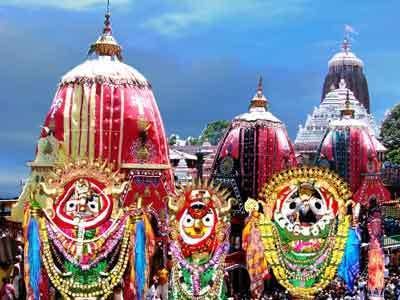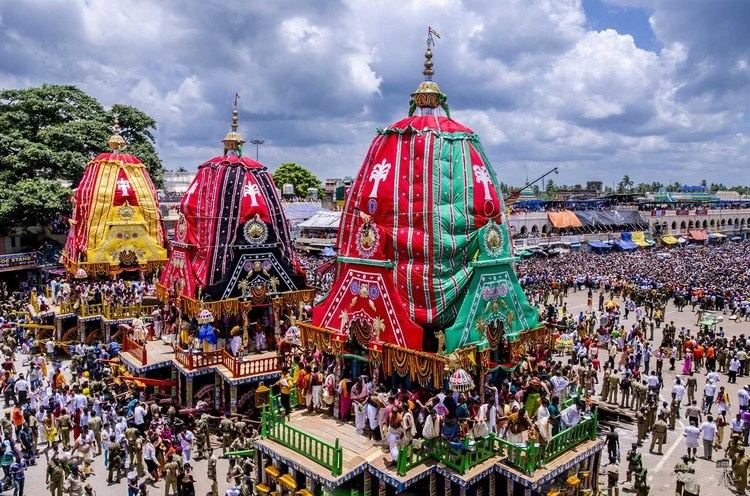Observed by Hindus 2016 date 6 July 2017 Date 25 June 2017 Featured in religions Hinduism | Begins Ashadha Shukla Dwitiya First time Puri, Odisha Type of holiday Religious celebration | |
 | ||
Ends Aashaadha Shukla Dashami Observances Involves moving deities Jagannath, Balabhadra, Subhadra and Sudarshana on ratha Similar Gundicha Temple, Thirumalai Nayakkar Mahal, Jagannath | ||
Ratha Yatra (/ˈrɑːtɑː/-/ˈjɑːtrɑː/; usually spelled ରଥଯାତ୍ରା;a transliteration also romanized as Ratha-Yatra or anglicized as Car festival or Chariot festival) is an Odia festival that involves moving deities Jagannath, Balabhadra, Subhadra and Sudarshana on a ratha or rotho, a wooden deula-shaped chariot).
Contents
- Etymology
- Examples
- Rath Yatra at Puri Odisha
- International Jagannath Ratha Yatra
- Dhamrai Jagannath Roth festival
- Ratha Yatra of Mahesh
- References

Notable ratha yatras include the Ratha yatra of Puri, the Dhamrai Ratha Yatra and the Ratha Yatra of Mahesh. The festival was originated in Puri, Odisha. The English word juggernaut was originated from Jagannath that is related to the massive and unstoppable "ratha" carrying Jagannath.

Etymology
Ratha-yatra is derived from two Odia words ratha/rotho meaning "chariot" and yatra meaning "journey". The festival involves an annual procession (journey) of deities. Other names for the festival are ratha jatra or chariot festival.
Examples

Rath Yatra at Puri (Odisha)

Triads are usually worshiped in the sanctum of the temple at Puri, but once during the month of Asadha (Rainy Season of Odisha, usually falling in month of June or July), they are brought out onto the Bada Danda (main street of Puri) and travel (3 km) to the Shri Gundicha Temple, in huge chariots (ratha), allowing the public to have darśana (Holy view). This festival is known as Rath Yatra, meaning the journey (yatra) of the chariots (ratha). The Rathas are huge wheeled wooden structures, which are built anew every year and are pulled by the devotees. The chariot for Jagannath is approximately 45 feet high and 35 feet square and takes about 2 months to construct. The artists and painters of Puri decorate the cars and paint flower petals and other designs on the wheels, the wood-carved charioteer and horses, and the inverted lotuses on the wall behind the throne. The huge chariots of Jagannath pulled during Rath Yatra is the etymological origin of the English word Juggernaut. The Ratha-Yatra is also termed as the Shri Gundicha yatra.
The most significant ritual associated with the Ratha-Yatra is the chhera pahara. During the festival, the Gajapati King wears the outfit of a sweeper and sweeps all around the deities and chariots in the Chera Pahara (sweeping with water) ritual. The Gajapati King cleanses the road before the chariots with a gold-handled broom and sprinkles sandalwood water and powder with utmost devotion. As per the custom, although the Gajapati King has been considered the most exalted person in the Kalingan kingdom, he still renders the menial service to Jagannath. This ritual signified that under the lordship of Jagannath, there is no distinction between the powerful sovereign Gajapati King and the most humble devotee.
Chera pahara is held on two days, on the first day of the Ratha Yatra, when the deities are taken to garden house at Mausi Maa Temple and again on the last day of the festival, when the deities are ceremoniously brought back to the Shri Mandir.
As per another ritual, when the deities are taken out from the Shri Mandir to the Chariots in Pahandi vijay.
In the Ratha Yatra, the three deities are taken from the Jagannath Temple in the chariots to the Gundicha Temple, where they stay for nine days. Thereafter, the deities again ride the chariots back to Shri Mandir in bahuda yatra. On the way back, the three chariots halt at the Mausi Maa Temple and the deities are offered Poda Pitha, a kind of baked cake which are generally consumed by the poor sections only.
The observance of the Rath Yatra of Jagannath dates back to the period of the Puranas. Vivid descriptions of this festival are found in Brahma Purana, Padma Purana, and Skanda Purana. Kapila Samhita also refers to Rath Yatra. In Moghul period also, King Ramsingh of Jaipur, Rajasthan has been described as organizing the Rath Yatra in the 18th Century. In Orissa, Kings of Mayurbhanj and Parlakhemundi were organizing the Rath Yatra, though the most grand festival in terms of scale and popularity takes place at Puri.
Moreover, Starza notes that the ruling Ganga dynasty instituted the Rath Yatra at the completion of the great temple around 1150 AD. This festival was one of those Hindu festivals that was reported to the Western world very early. Friar Odoric of Pordenone visited India in 1316-1318, some 20 years after Marco Polo had dictated the account of his travels while in a Genoese prison. In his own account of 1321, Odoric reported how the people put the "idols" on chariots, and the King and Queen and all the people drew them from the "church" with song and music.
International Jagannath Ratha Yatra
The Ratha Yatra festival has become a common sight in most major cities of the world since 1968 through the ISKCON Hare Krishna movement. By the mercy of Lord Jagannath and Caitanya Mahāprabhu, His Divine Grace A. C. Bhaktivedanta Swami Prabhupada successfully transplanted the festival which now happens on an annual basis in places all over the world in over 108 cities including; San Francisco, New York, Los Angeles, Montreal, Toronto, Vancouver, London, Dublin, Belfast, Manchester, Birmingham, Paris, Madrid, Oslo, Stockholm, Copenhagen, Amsterdam, Rome, Zürich, Cologne, Florence, Berlin, Heidelberg, Budapest, Wroclaw, Sydney, Perth, Auckland, Melbourne, Moscow, Mumbai, Kolkata, Karachi, Kampala, Nairobi, Mombasa, Kisumu, Mexico City, Alchevsk, Buenos Aires, Bath, Santiago, Tallinn, Lima, Antwerp, Sofia, Kuala Lumpur, Zhongshan, Myitkyina, Singapore, Bangkok and many other cities.
Dhamrai Jagannath Roth festival
Dhamrai Jagannath Roth is a chariot temple, a Roth, dedicated to the Hindu God Jagannath located in Dhamrai, Bangladesh. The annual Jagannath Roth Jatra is a famous Hindu festival attracting thousands of people. The Roth Jatra in Dhamrai is one of the most important events for the Hindu community of Bangladesh. The original historical Roth was burnt down by the Pakistan Army in 1971 The Roth has since been rebuilt with Indian assistance.
Ratha Yatra of Mahesh
The Ratha Yatra of Mahesh is the Second oldest chariot festival in India (after Rath Yatra at Puri) and oldest in Bengal, having been celebrated since 1396 A.D. It is a month-long festival held at Mahesh in Serampore of West Bengal and a grand fair is held at that time. People throng to have a share in pulling the long ropes (Roshi) attached to the chariots of Lord Jagannath, Balarama and Subhadra on the journey from the temple to Gundicha Bari (Masir bari) and back.
